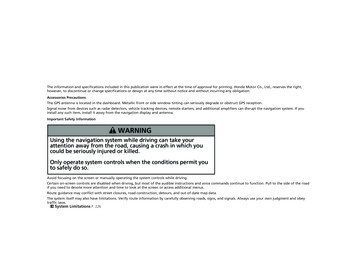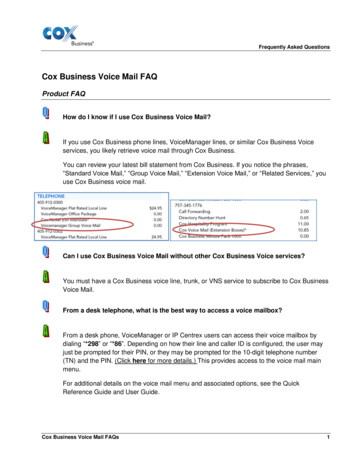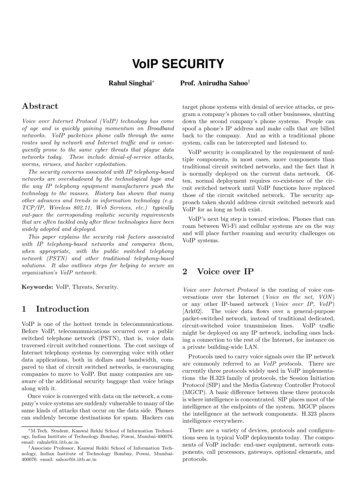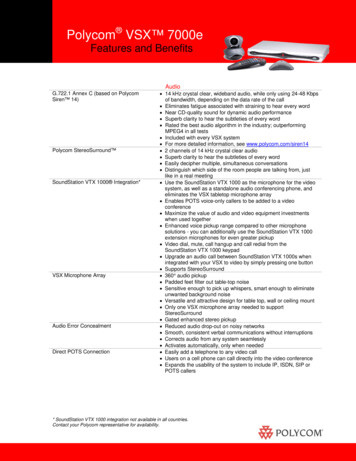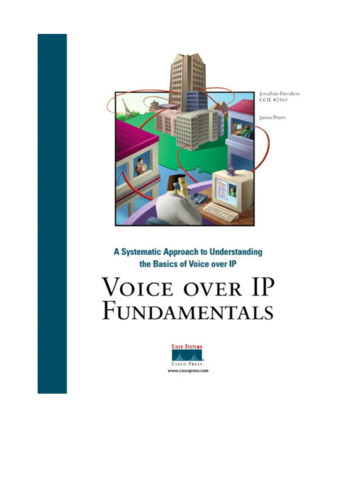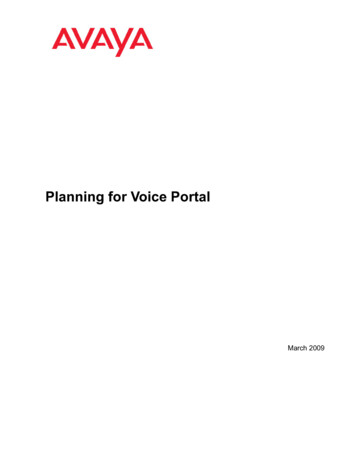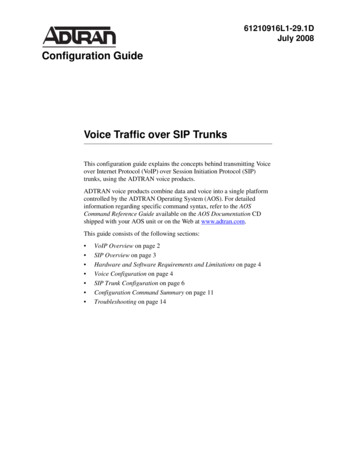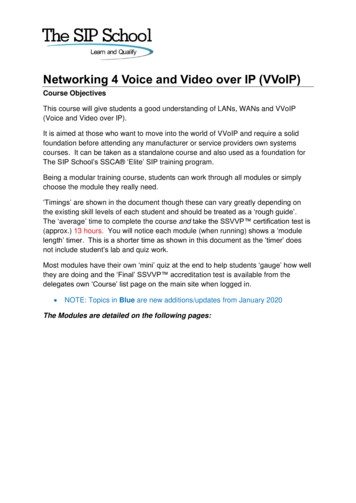
Transcription
Networking 4 Voice and Video over IP (VVoIP)Course ObjectivesThis course will give students a good understanding of LANs, WANs and VVoIP(Voice and Video over IP).It is aimed at those who want to move into the world of VVoIP and require a solidfoundation before attending any manufacturer or service providers own systemscourses. It can be taken as a standalone course and also used as a foundation forThe SIP School’s SSCA ‘Elite’ SIP training program.Being a modular training course, students can work through all modules or simplychoose the module they really need.‘Timings’ are shown in the document though these can vary greatly depending onthe existing skill levels of each student and should be treated as a ‘rough guide’.The ‘average’ time to complete the course and take the SSVVP certification test is(approx.) 13 hours. You will notice each module (when running) shows a ‘modulelength’ timer. This is a shorter time as shown in this document as the ‘timer’ doesnot include student’s lab and quiz work.Most modules have their own ‘mini’ quiz at the end to help students ‘gauge’ how wellthey are doing and the ‘Final’ SSVVP accreditation test is available from thedelegates own ‘Course’ list page on the main site when logged in. NOTE: Topics in Blue are new additions/updates from January 2020The Modules are detailed on the following pages:
What is VVoIP?This is an introduction module that sets out the scope of the course and introducesthe concepts of LANs and WANs.ooRunning time 3m 20sTotal 3m 20sNetworking ComponentsThis module is designed to introduce you to Data networks and how devices connectto them. It does this by describing the most commonly used topologies and cablingtypes in use today. TopologiesWhat is a Protocol?UTP and STP CablesRJ-45 ConnectorsUTP ImplementationsPower over Ethernet, POE Plus and 4PPOEFiber OpticsoooRunning time 10m 28sQuizzes 3m (average)Total 13m 28sEthernetEthernet is the predominant force in networking today and this module introduces allof the concepts needed to understand this specification along with introducing basicnetwork components like LAN cards and LAN switches. Ethernet and 802.3Ethernet ‘Types’NIC CardsHubs and EthernetCollisions and CSMA/CDRepeatersBridgesLAN switchesRoutersBandwidthoooRunning time 8m 50sQuizzes 3m (average)Total 11m 50s
The OSI ModelThe OSI Model was designed to break networking components and software into‘bite-size’ interoperable chunks. This module explains the 7 layers of the OSI modeland compares them to the real-world implementation of the TCP/IP layered model. The Reasons for OSIThe 7 LayersRole of the ‘Application’ layersRole of the ‘Data’ layersOSI v TCP/IPPhysical Layer functionsDatalink Layer functions and MAC addressesIEEE 802.2/3 Frame formatSwitches and the Datalink layerNetwork Layer FunctionsIPv6 introductionTransport Layer FunctionsEncapsulation / De-encapsulationoooRunning time 14m 50sQuizzes 3m (average)Total 17m 50sTCP/IP NetworksThis module explains how TCP/IP networks work by describing the functionality ofeach TCP/IP layer. By understanding these layers you will understand how aTCP/IP network works which will give you a good understanding of how voice can becarried across an IP network. TCP/IP Protocol StackApplication Layer overviewTransport Layer overviewPorts and SocketsTCP/IP Internet Layer – OverviewAddress Resolution Protocol – ARPIP DatagramsICMPMultipath TCP (MPTCP)Stream Control Transmission Protocol - SCTPoooRunning time 13m 27sQuizzes 3m (average)Total 16m 27s
WANSWide Area Networks connect buildings, homes and people together. This moduleaims to explain what a WAN is and how they work along with explaining some WANprotocols such as PPP, ADSL, Frame Relay and the newly popular - MPLS What is a WAN?DTE/DCE and DSU/CSUSynchronous communicationsThe Point to Point Protocol – PPPDSL‘Local Loop’ unbundlingADSL @ HomeADSL Channels and Contention ratiosADSL DevelopmentsVDSL2Fiber optionsFinding an ISPFrame RelayEPS9/EPS8LAN Extension ServicesEFM, Ethernet, GEACable networksWAN Physical Layer implementationsMPLS and its BenefitsMetro EthernetVirtual Private LAN service (VPLS)WAN Optimization, Hybrids and SD-WANVirtual Private Networks (VPNs)VPNs for BusinessGet your own VPNoooRunning time 33m 20sQuizzes 3m (average)Total 36m 20s
TCP/IP AddressesIP Addresses, Subnet Masks, Default Gateways. It’s all here and delivered to you ina way so that you will understand what these numbers are for and how they workwith each other. AnalogiesBinary and HexadecimalThe IP addressIP Address Classes – A, B, C and more!Special IP addresses 127.0.0.0 the ‘loopback’ APIPA and the 169 networkTCP/IP addressing quizzesThe Subnet maskIP Address and Subnet mask ‘in combination’Sample IP networksAddressing without subnetsWhy subnet at all?How many Subnets do you need?Easy SubnettingoooRunning time 25m 3sQuizzes (inc. exercises) 120m (average)Total 145m 3sDHCPThis Module introduces the Dynamic Configuration protocol (DHCP) and describeswhat it is, how it works and how it works in a multi-network environment along withintroducing some troubleshooting commands. Overview of DHCPStatic or Dynamic addressingDHCP DiscoveryDHCP OffersLease and Renewal TimesMultiple DHCP ServersRelay AgentsDHCP ‘Extra’ OptionsIPConfig utilityHome setup ‘example’ooooRunning time 10m 41sQuizzes 3m (average)Lab Exercises 8m (average)Total 21m 41s
Troubleshooting IP NetworksFollow the tips in this module and you will be able to solve the majority of problemsyou will encounter on a Network. Troubleshooting RulesLayer 8Are you connected?Ping utilityLoopback addressIPConfig utilityAPIPA addresses (revisited)Ping TestsTroubleshooting exercisesMore PING toolsNet Shell – netsh PowerShellooooRunning time 18m 20sQuizzes 3m (average)Lab Exercises 10m (average)Total 31m 20sAn Introduction to WiresharkThis module teaches you how to use Wireshark to analyse traffic on the network inorder to help troubleshoot even the more difficult of problems. Where? and What? to MonitorWireshark basic screen layoutCapturing (and Saving) TrafficAnalysing FramesPCAP format explainedDNS AnalysisColouring RulesDHCP AnalysisYour turn to AnalyseLANs, WANs and Wi-Fi adviceoooRunning time 16m 56sLab Exercises 60m (average)Total 76m 56s
SNMPThe Simple Network Monitoring Protocol is a valuable protocol that enables NetworkOperation centres to keep an eye on valuable systems and services across anetwork. This module is an introduction to this important protocol SNMP ComponentsManagers and AgentsThe Management Information Base – MIBThe SNMP Name treeSNMP Get RequestOther SNMP CommandsConfiguring SNMP in WindowsTesting SNMPooooRunning time 5m 47sQuizzes 3m (average)Lab Exercises 10m (average)Total 18m 47sSwitches and VLANSThis module explains the fundamental operation of a LAN switch along with theimportant concepts of Virtual LANs (VLANS). Switch FunctionsLAN Switch StructureAddress learningFiltering and Forwarding FramesBroadcast FramesRedundant TopologiesBroadcast Storms and LoopsMultiple Frame CopiesMAC table instabilityThe Spanning Tree ProtocolHow STP worksVLANS802.1Q/P TaggingConnecting VLANsRouter Sub-interfacesPer-VLAN Spanning tree (PVST )Rapid Spanning Tree - 802.1wMultiple Spanning Tree (MST)Layer 3 SwitchesoooRunning time 15m 04sQuizzes 3m (average)Total 18m 04s
RoutingRouters are used on the edge of networks to pass data onto a WAN and within Layer3 LAN switches. This module describes how routers work along with a briefexplanation of Routing protocols. What is Routing?RoutersPort guidesStatic and Dynamic routesDefault RoutesRouting DecisionsDistance Vector Routing ProtocolsRIP and Routing Table updatesInterior Gateway Protocol – IGRPOther Routing ProtocolsTesting Routes with TraceRT (Trace Route)Alternative Trace toolsInternet traffic reportSoftware Defined Networking (SDN), OpenFlowSoftware Defined WAN (SD-WAN)Open Networking Foundation (ONF)oooRunning time 17m 14sQuizzes 10m (average)Total 27m 14sWireless NetworksWireless is one of the fastest moving areas in the world of networking. This moduleexplains the basics of Wireless networking along with information on securing yourwireless network. Wireless NetworksWireless BridgingWi-Fi and SpecificationsWi-Fi 6Wi-Fi AnalysersWiMAXVoWi-FiWireless SecurityBluetoothCellular networksCellular speeds from 2G to 5G
Vo-LTESatellite networksWi-Fi and the Internet of ThingsoooRunning time 24m 50sQuizzes 3m (average)Total 27m 50sIP Applications (and Services)So many other services can be found on a network and some, if not all, will have animpact on how your voice will work. This module looks at services such as FTP,TFTP, Firewalls, NAT, Proxy Server, DNS and VPNS. IP ApplicationsFTP – File Transfer ProtocolSetting up an FTP ServerFTP ClientsConnecting to FTPTransferring files‘More’ FTP ClientsOther FTP ServersTFTP - Trivial File Transfer ProtocolFirewallsNetwork Address TranslationNetwork Address (and Port) TranslationProxy ServersTelnetDNS – The Domain Name SystemDNS Root ServersDNS DiscoveryVirtualizationNetwork Functions Virtualization (NFV)oooRunning time 26m 11sQuizzes 3m (average)Total 29m 11s
Voice over IP (VoIP)This module introduces the different implementations of Voice over IP and describesthe basics of codecs, signalling, the real time protocol (RTP), quality of service (QoS)and the basics of network design to reduce delay and jitter that can affect the qualityof voice on a network. What is Voice over IPVoIP in the OSI modelVoIP over the InternetBranch to Branch VoIPSignaling pathsSpeech pathsIP PBX advantagesEncodingCodec typesRTP – The Real Time ProtocolBandwidth RequirementsDelay, Jitter and Packet LossMeasuring DelayJitter and Packet LossPing tests and VoIP speed testingVoIP acceptance criteriaLAN guidelines for Voice qualityDedicated voice LANShared LAN for Voice and DataUtilizing VLANS and 802.1QVLAN Tagging and Priority for QoSVLAN QoS ‘trace’ exampleQuality of Service for Wide Area NetworksQoS everywhere!VoIP SecurityoooRunning time 27m 55sQuizzes 3m (average)Total 30m 55s
Hosted VoIPHosted voice over IP is a new way of delivering top quality telephone solutions tocustomers at very low cost. This module is designed to be an introduction to hostedvoice over IP and covers: Hosted TelephonyA ‘traditional’ Phone SystemA Hosted SolutionProvisioningQuality considerationsQoS considerations for hosted VoIPoooRunning time 7m 58sQuizzes 3m (average)Total 10m 58sVideo over IPAs well as Voice running over IP, Video is doing so as well. This module is designedto introduce the concepts of Video of IP as well as describing the codecs, Signalingand other elements that make this area of communications so engaging. What is Video over IP?Video Transmission TypesUnicast vs. MulticastVideo Conferencing typesVideo Resolution and PixelsVideo FormatsCodecs for Video and VoiceH.264, H.265 (HVEC)More inc. VP8 and VP9Multipoint ConferencingMultipoint Control Unit (MCU)MCU and IP PBXSimulcasting with AVCH.264 Scalable Video CodingVideo GatewaysBandwidth ConsumptionData vs. VVoIP BandwidthControl your networkVideo device landscapeVideo in the CloudThe Video Codec ‘Battle’The i3 Forum (and OVCC)oooRunning time 47m 04sQuizzes 3m (average)Total 50m 04s
IPv6The IPv4 address space is almost gone and IPv6 is the answer to this problem. Aswell as explaining what IPv6 is along with all its benefits, this module covers what IPaddressing is all about along with configuring a PC for IPv6 connectivity and testing. IPv4 to IPv6IPv6 BenefitsThe IPv6 HeaderIPv6 addressingUnicast, Multicast, AnycastNeighbor Discovery (NDP)ICMPv6 (and Ping)IPv6 address allocationStateless Address Autoconfiguration (SLAAC)Routers and IPv6DHCPv6DNSv6DNS Root Servers and IPv6Transition technologies and TunnellingConfiguring and testing IPv6 on a PCMore testing commandsThe effects of IPv6 on Voice and Video over IPResources and websitesooooRunning time 72m 30sQuizzes 5m (average)Lab Exercises 60m (average)Total 137m 30sNote:An access license for any of our training courses and certification tests is for 12months from the date of purchase.
Hosted voice over IP is a new way of delivering top quality telephone solutions to customers at very low cost. This module is designed to be an introduction to hosted voice over IP and covers: Hosted Telephony A 'traditional' Phone System A Hosted Solution Provisioning Quality considerations
